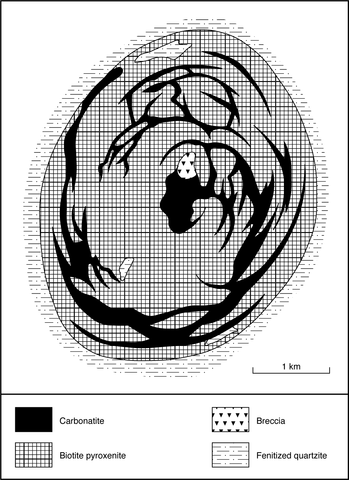stripes
Glenover is a plug of pyroxenite and carbonatite, oval in outline, and emplaced in quartzites which are not, however, exposed in the immediate vicinity. The geology is obscured by blown sand, superficial calcretes, fragmental rocks and laterite but Verwoerd (1967) was able to map the complex with the help of trenches and drill holes. The principal rock type is biotite pyroxenite which is cut by sheets of carbonatite. The pyroxenite is banded with predominantly micaceous layers alternating with pyroxenite and some massive magnetite bands. Apatite is abundant and locally may comprise 20%. The pyroxene is diopsidic and the mica biotite with phlogopite and vermiculite also occurring. Calcite is widespread and perovskite, schorlomite, rutile, magnetite, anatase, pyrite, chalcopyrite and zircon also occur. The innermost carbonatites are principally beforsite while sovite is found mainly in the outer areas of the plug, the two types appearing to have gradational relationships. The beforsite is a medium- to coarse-grained dolomite rock, sometimes with a little calcite and apatite, magnetite and phlogopite; other minerals identified include pyrochlore, columbite, chondrodite, barite, celestite, galena, bornite, sphalerite and chalcopyrite. Sovite contains magnetite, apatite and phlogopite which may be concentrated in flow layers. There are also rocks containing approximately equal amounts of calcite and dolomite and microscopic evidence suggests replacement of dolomite by calcite. Late stringers of quartz occur throughout the carbonatites occasionally reaching 30 cm in thickness and containing tiny radiating aggregates of synchysite. Fluorite veins with barite, quartz, synchysite and a little carbonate also occur. Late thin dykes of ankerite cut the principal carbonatites. A small hill at the centre of the complex is underlain by a ferruginous apatite-rich rock which forms a body about 200 m in diameter, and extending to a depth of about 160 m (Verwoerd, 1986). The apatite rock forms fragments from several centimetres to many metres across which assay 33-37% P2O5 and lie in and are cut by veins of ferruginous earth consisting of iron oxides and small apatite grains which assays 20-35% P2O5. An outer zone of earthy ferruginous rock is radioactive and gives Nb2O5 values up to about 1% and P2O5 up to 20%. Drilling has indicated that this body may be intrusive with late secondary phosphate enrichment (Verwoerd, 1986). Fenites are known as fragments around the complex but there is little outcrop. They comprise partially fenitized quartzites with alkali feldspar, aegirine-augite and green amphibole as well as rocks consisting of aegirine-augite and perthite. Verwoerd (1967) gives two chemical analyses of carbonatite and details of radiometric and magnetic surveys over the complex.
VERWOERD, W.J. 1967. The carbonatites of South Africa and South West Africa. Geological Survey of South Africa, Handbook, 6: 1-452VERWOERD, W.J. 1986. Mineral deposits associated with carbonatites and alkaline rocks. In C.R. Anhaeusser and S. Maske (eds), Mineral deposits of Southern Africa, 2: 2173-91. The Geological Society of South Africa, Johannesburg.

